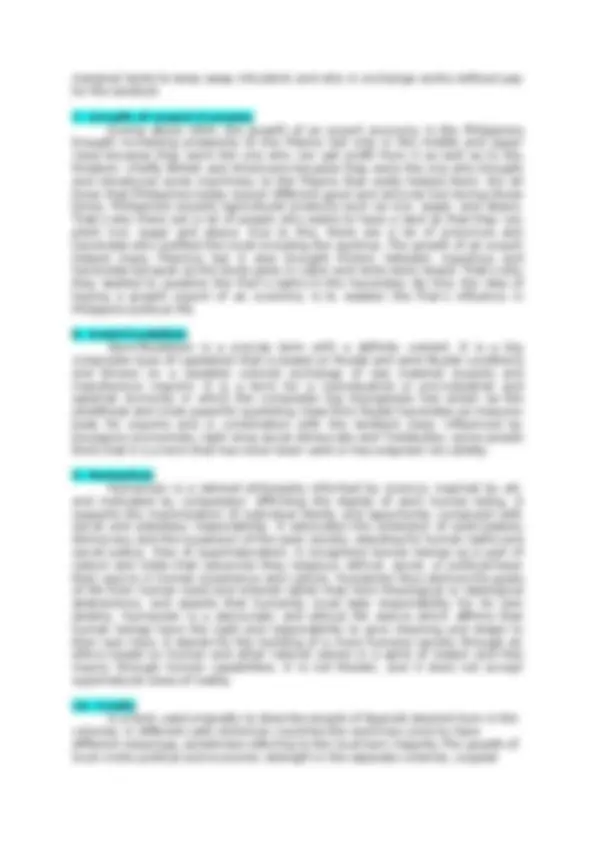




Study with the several resources on Docsity

Earn points by helping other students or get them with a premium plan


Prepare for your exams
Study with the several resources on Docsity

Earn points to download
Earn points by helping other students or get them with a premium plan
Community
Ask the community for help and clear up your study doubts
Discover the best universities in your country according to Docsity users
Free resources
Download our free guides on studying techniques, anxiety management strategies, and thesis advice from Docsity tutors
Make a graphic organizer covering the different developments in the Philippines in the 19th Century. The graphic organizer should be able to show the connection(s) of these developments to Rizal and/or his family.
Typology: Assignments
1 / 4

This page cannot be seen from the preview
Don't miss anything!



Activity no. 2 Instruction: Make a graphic organizer covering the different developments in the Philippines in the 19th Century. The graphic organizer should be able to show the connection(s) of these developments to Rizal and/or his family.
The economic growth made important consequences in politics. Because of this, modernized Filipinos saw the colonial policies of Spain as a hindrance of economical and political progress and a threat to everything that they achieved. So nationalists like Rizal himself began to flourish.
The increasing growth of exporting in the Philippines brought prosperity to the middle and upper class Filipinos who were in a petition to profit by it. They bargain agricultural products with other countries so Filipino Hacenderos, friars, and inquilinos profited the most in that time. Domingo Lam- co, Rizal's Chinese ancestor in the father's side is one of them. Religious Development Long before the arrival of the Spanish, the indigenous Filipinos had their own religions. The Filipinos appeared to have absorbed Catholicism from the Spanish after over 400 years of Spanish involvement in the Philippines. Changes in religious beliefs should be mirrored in changes in practices, which can be detected in the archaeological record, especially in shift in burial traditions. The location of burials, position of both the body and burial goods, and decoration of burial goods may indicate ritual. Despite claims made by the Spanish about the overwhelming acceptance of Catholicism in the Philippines, the influence of Spanish colonialism was not as widespread as was advertised. The indigenous Filipinos continued their own burial practices, and thus continued to follow their own religions, beyond the influence of Spanish colonialism which was centered in and immediately surrounding large trade cities.
The cultural change accompanying the fast expansion of education from 1860 was a crucial factor in the formation of nationalism in the late nineteenth century. The return of the Jesuits had a significant impact on educational advances in the nineteenth century. Returning in 1859, they took charge in the evangelization of Mindanao and also returned with ideas and methods new to the Philippine Educational System. Greek, French, and English were added to the Languages studies aside from the initial Spanish and Greek. Ideas about nationalism was now then awaken in secondary school during these times.
Instruction: Explain the concept of the following key terms and phrases;
1. Anti-Clericalism Is an opposition to the clergy or the people ordained for religious duties especially in the Catholic church. Anti-Clericalism is based on having doubts about alleged influence in political and social affairs for its doctrinarism, for its privileges or property, or for any other reason. 2. Illustrados Is a Spanish word which means "erudite" or "learned" used by the Spaniards during the Spanish colonial period in the Philippines. It refers to the middle class society who were educated in Spain and exposed to Spanish liberal and European nationalist ideals. Other terms used during this period to cut across racial lines were Indios, Insulars and Mestizos. 3. Liberals Liberals are the supporters of policies that are socially progressive and promote social welfare, these individuals and parties are willing to respect or accept behaviour or opinions different from one's own (open to new ideas). Liberals adopt or support a wide array of views depending on their understanding of these principles, but they generally support individual rights (including civil rights and human rights), democracy, secularism(principle of separation of the state from religious institutions), freedom of speech, freedom of the press, freedom of religion and a market economy. 4. Conservatists Conservatizes are who supports conservative forces, principles, ideas. Conservative comes from the word conserve which means to protect from harm or destruction. Conservatism is the aesthetic, cultural, social, and political outlook that embodies the desire to conserve existing things, held to be either good in themselves, or better than likely alternatives, or at least safe, familiar, and the object of trust and affection. The central tenets of conservatism may vary in relation to the traditions and values of the culture and civilization in which it appears. Example: in western culture, conservatives seek to conserve a range of things such as organized religion, property rights, parliamentary government, family values, the natural environment, and classical and vernacular architecture. 5. Radicals During nineteenth century there were a lot of changes that that had been taking place within Spain including their repercussions within the Philippines. The first three quarters of the nineteenth century had been the period of almost uninterrupted chaos and tumult for Spain. They became the under cover of the war of independence against French invaders and the “intruder king”, Joseph Bonaparte. Liberals also suffered more or less after the death of Fernando. In 1835 and1835, mobs burned religious houses and murdered many of their occupants in the city of Spain. When Isabel II was overthrown, the revolutionary drew up a radical Constitution of 1869 where the provisional government began to look for a monarch. After 2 years, the provisional chose Amadeo as king. This radical Constitution of 1869, reflected the progressive and democratic set of ideals. It allows them to have the freedom to worship. 6. Inquilinos A person who held a near-hereditary lease on agricultural land in the Spanish Philippines, In historic Chilean agriculture an inquilino is a labourer indebted to a landlord who allows him to form a farm in parts of his property (usually in the
with their global geographic distribution, led them to each evolve separate (both from each other and Spain) organic national identities and viewpoints. During the Spanish American Wars of Independence, Criollos like Simon Bolivar and Jose de San Martin became the main supporters of independence from Spanish rule.